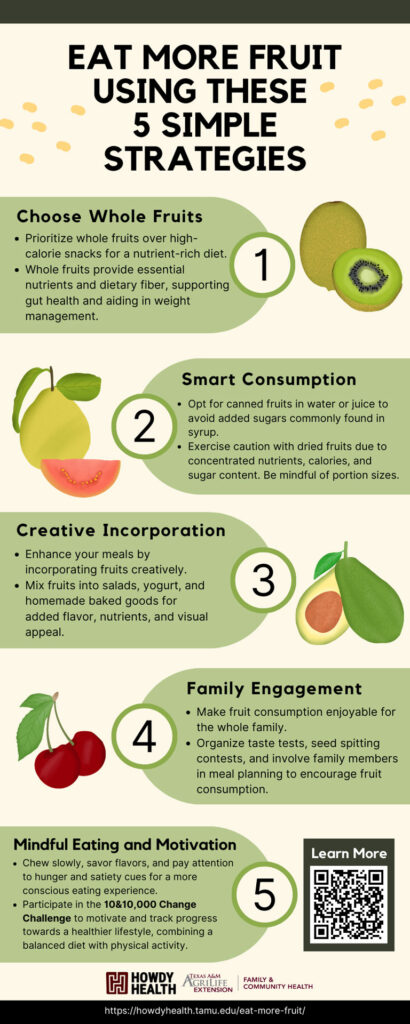A healthy diet should include a daily intake of fruits, especially whole fruits, over other high calorie sweets and snacks. Fruit offers the best nutrition in its whole form. Although you can still occasionally enjoy a glass of 100% fruit juice, it is not the best choice for daily consumption. Whole fruits are good sources of dietary fiber, which is mostly lost when juiced. Fiber improves your gut health and takes longer for your body to digest keeping you full for a long time. Consuming a high fiber diet on a regular basis may help lower blood cholesterol levels and can promote weight loss.
Fruits that are in the following forms all retain their nutrients and are good choices for consumption:
- Cut up
- Canned
- Fresh
- Frozen
- Dried
- Freeze-dried
If choosing canned fruit, choose those canned in water or fruit juice, rather than syrup, to avoid added sugars. If choosing dried or freeze-dried fruit, be sure to stay hydrated to make up for the lack of water. Be mindful of your portion sizes when consuming dried and freeze-dried fruits because they lose water during the drying process, and therefore, they become concentrated in nutrients, calories, and sugar content.1,2
Consider some creative ways to eat more fruit to get the benefit of their many nutrients. Here are 5 simple strategies to help you eat more fruit:
1. Make your own 100-calorie (or less) fruit snack-pack.
Instead of a high-calorie snack-pack from the vending machine, create your own snack-pack of fruit. While a snack-sized bag of chips or cookies often contains 150-250 calories with little to no nutrients, these fruit options are all 100 calories or less:
- 1 medium-size apple (72 calories)
- 1 small 6″ banana (90 calories)
- 1 cup blueberries (83 calories)
- 1 cup grapes (100 calories)
- 1 cup sliced strawberries (53 calories)
- 1 cup diced mango (99 calories)
- 1 medium kiwifruit (42 calories)
- 1 clementine (25 calories)3,4
2. Mix fruit into other healthy foods.
Mix fruit into other healthy foods you’re already eating. Bright colored fruits not only taste delicious and look visually appealing but also provide the most nutrients as well. Below are a few tips to experiment with a rainbow of colored fruits:
- Add sliced grapes, pineapple chunks, dried cranberries, mandarin oranges, or diced apples to your chicken or tuna salad.5
- Cut up your favorite fresh fruit and add it to plain Greek yogurt to make your own healthy, fruit-filled yogurt without added sugars.5
- Skip the sugar and syrup and make your own blueberry, raspberry, strawberry, or peach puree for topping oatmeal, or whole grain biscuits, toast, pancakes, or waffles.5
- Spread pureed cranberries on your turkey or chicken sandwich.
- Grill fruit kabobs to go with your barbeque.5 Try apples, apricots, nectarines, peaches, pineapples, and plums on the grill.6
- Mix fruit into your homemade baked goods, such as muffins, cakes, or pies.5 Use fruits, like overripe bananas, applesauce, dates, or avocado in place of sugars, butter, or oil in your baked goods.
- Top your salad with fresh fruit and make your own whole fruit-based salad dressing. Try some of these great ideas, including raspberry, mango, apple, strawberry, and blackberry dressing.7
- Try fruit-in-a-jar. Salads prepared in a mason jar have been all the rage. Why not try fruit-in-a-jar. Layer any combination of fruit. Try diced or sliced fruits of your choice. Squeeze any citrus juice you like over fruits that tend to brown (like apples or pears). Add a small container of plain Greek yogurt on top to use as a dip. Add a small baggie of nuts, granola, chia seeds, or whole grain cereal to sprinkle atop the yogurt for some added flavor and crunch. Research suggests that the visual appeal of foods can add to our consumption of them, particularly among children.8 So why not layer it up in this eye-appealing fashion for you and your family.
3. Choose a new fruit (recipe) each week.
Eating fruits in a variety of different types and colors will help you get many of the nutrients your body needs. One way to do this is to add a new fruit, or a new fruit-containing recipe, each week. It can be helpful to be familiar with the variety of fruits available to you.
Currently, the 20 most popular fruits in the United States in order of popularity are:
- Bananas
- Apples
- Grapes
- Strawberries
- Melons
- Avocados (yes, they’re a fruit)
- Blueberries
- Mandarins
- Oranges
- Peaches/nectarines/plums (tied)
- Pineapple
- Raspberries
- Cherries
- Blackberries
- Pears
- Lemons
- Limes
- Kiwis
- Grapefruit
- Mangos.9
Choose fruits from this popular list, or try more exotic, lesser-known fruits, like finger limes, mangosteen, longan, dragon fruit, rambutan, loquat, guava, horned melon, cherimoya, jackfruit, or passion fruit.10 Choose fruits that are in season.11 Foods that are in season are those that are purchased and consumed around the same time they’re harvested.12
- Seasonal produce matures longer on the plant, which makes it more nutrient-dense when compared to being picked before its prime.
- Seasonal produce usually tastes better since it’s been picked at the peak of flavor.
- Seasonal produce is also typically sold at its best price, which helps with the budget.13
You can download the Seasonal Food Guide App to help you find fruits (as well as veggies, legumes, nuts, and herbs) that are in season.12
When seasonal fruit is not an option, frozen fruit is a great choice. Frozen fruits are picked at the peak of ripeness and then flash-frozen to maintain their many nutrients.
4. Get the family involved to eat more fruit.
Getting everyone at your table involved in meal selection and preparation can help increase both interest and intake.
- Do a taste test. Blindfold family members and have them try different varieties of apples, berries, melons, or lesser-known fruits, like jackfruit, starfruit, dragon fruit, passion fruit, loquat, or mulberries. Have them vote for their favorites.
- Have a seed spitting contest. Take it outside as you delve into a seeded watermelon or a handful of cherries and see who can spit their seeds the furthest. Making it fun can help children become more interested. (Note: Only do this with older children for whom the seeds are not a choking hazard.)
- Plate your food with fruits in different shapes. Make a smiley face on your child’s plate with blueberry eyes, a strawberry nose, and a half a banana mouth. Make a heart with strawberries, raspberries, or cherries for Valentine’s Day or any day. Make other holiday-themed shapes, like cut up cantaloupe in the shape of a pumpkin for Halloween or Thanksgiving; try kiwifruit in the shape of a Christmas tree, or blueberries and strawberries laid out like an American flag for 4th of July. Search edible fruit and vegetable art ideas for a myriad of fun ideas for any day.
- Let each family member have a night to choose which fruit is served, or allow each family member to plan a meal that incorporates fruit into each entrée.
- Plan regular fun cooking projects with your little chefs at home. Make them get excited to try different kid-approved fruit recipes every week. Some recipes that involve little to no cooking are rainbow salad, fruit kabobs, watermelon pizza, fruit sandwiches, fruit carvings, fruit and yogurt popsicles, and fruit sushi. Invest in a kid-friendly knife and peeler to help children learn basic knife skills and be more confident and independent in the kitchen.
5. Practice mindful eating.
- Mindful eating is being self-aware and paying attention to your internal and external cues that determine your food choices. Use mindful eating techniques to help you enjoy fruit to its fullest. Stop to look at the fruit on your plate and appreciate its visual appeal.
- Smell the fruit and pay attention to its aroma alone or paired with other flavors on your plate.
- Slow down and savor the flavor. Chew slowly, appreciating the texture of the fruit. Slowing down can aid in digestion and can also help you recognize when you’re becoming full.
- Notice how your body feels before and after eating the fruit. By observing your physical cues for hunger and satiety, you can learn to differentiate between the need for nourishment and emotional food cravings.
- Appreciate your food and think about how your food choices affect your health and the environment.
So, remember, take time to choose fruits in season and make snack-packs for on-the-go success. Try a new fruit-filled recipe or mix fruit into foods you’re already preparing. Add a little fun and creativity to your plate, and be sure to savor the flavors of fruit at any or every meal – all year long.
Want a little motivation to make healthy dietary choices?
Try our 10&10,000 Change Challenge. This Free and simple web app kick starts and helps you achieve the end goal of eating 7 to 13 servings of fruits and vegetables, as well as walking 10,000 steps per day. Complete 3 Tip Task videos during each stage of the challenge to help you change your behavior for the better.
Infographic
Download the PDF or share the image below to help others learn three easy ways to eat more fruit.
Eat More Fruit Using These 5 Simple Strategies – Infographic (pdf)
- Produce for Better Health Foundation. About the buzz: Fresh fruit is much healthier than dried fruit? Have A Plant. April 8, 2019. Accessed November 22, 2023. https://fruitsandveggies.org/stories/atb-for-062911/.
- Columbia University. Nutrition of freeze-dried vs. raw fruits and vegetables. Go Ask Alice! November 26, 2014. Accessed November 22, 2023. https://goaskalice.columbia.edu/answered-questions/nutrition-freeze-dried-vs-raw-fruits-and-vegetables/.
- S. Department of Agriculture. 1. Fooddata Central Search Results. FoodData Central. Accessed November 27, 2023. https://fdc.nal.usda.gov/fdc-app.html#/.
- Centers for Disease Control and Prevention. 1. How to use fruits and vegetables to help manage your weight. Accessed November 27, 2023. https://www.cdc.gov/nccdphp/dnpa/nutrition/pdf/CDC_5-A-Day.pdf.
- NYC Nutritionist NY Nutrition Group. Extreme produce! 6 creative ways to add more fruits and vegetables to all your meals. NYC Certified Nutritionist, Registered Dietitian, Expert Nutrition Therapist & Online Coaching New York City. March 22, 2023. Accessed November 27, 2023. https://www.nycnutritionist.net/6-creative-ways-to-add-fruits-and-vegetables-to-meals-new-york-city-nutrition-advice/.
- Produce for Better Health Foundation. Fruits and veggies – the thrill of the Grill. Have A Plant. April 8, 2019. Accessed November 27, 2023. https://fruitsandveggies.org/stories/fruits-and-veggies-the-thrill-of-the-grill/.
- Ford K. Raspberry vinaigrette and more fruity salad dressings. The Veg Space. July 28, 2021. Accessed November 27, 2023. https://www.thevegspace.co.uk/recipe-5-fruity-salad-dressings/.
- Chung LMY, Fong SSM. Appearance alteration of fruits and vegetables to increase their appeal to and consumption by school-age children: A pilot study. Health psychology open. September 25, 2018. Accessed November 27, 2023. https://www.ncbi.nlm.nih.gov/pmc/articles/PMC6158620/.
- Produce for Better Health Foundation. Top 20 fruits and vegetables sold in the U.S. 2022. International Fresh Produce Association. November 12, 2021. Accessed November 27, 2023. https://www.freshproduce.com/resources/consumer-trends/top-20/.
- Neville K. Embrace the exotic with these funky fruits. Food & Nutrition Magazine. July 28, 2017. Accessed November 27, 2023. https://foodandnutrition.org/march-april-2017/embrace-exotic-funky-fruits/.
- S. Department of Agriculture. Seasonal produce guide. SNAP Education Connection. Accessed November 27, 2023. https://snaped.fns.usda.gov/resources/nutrition-education-materials/seasonal-produce-guide.
- Grace Communications Foundation. A Free Seasonal Food Almanac, Right at Your Fingertips. Seasonal Food Guide. Accessed November 27, 2023. https://www.seasonalfoodguide.org/download-app.
- Mayo Clinic. Picked at their peak: The benefits of eating seasonal produce. Accessed November 27, 2023. https://diet.mayoclinic.org/us/blog/2022/picked-at-their-peak-the-benefits-of-choosing-and-eating-seasonal-produce/.





